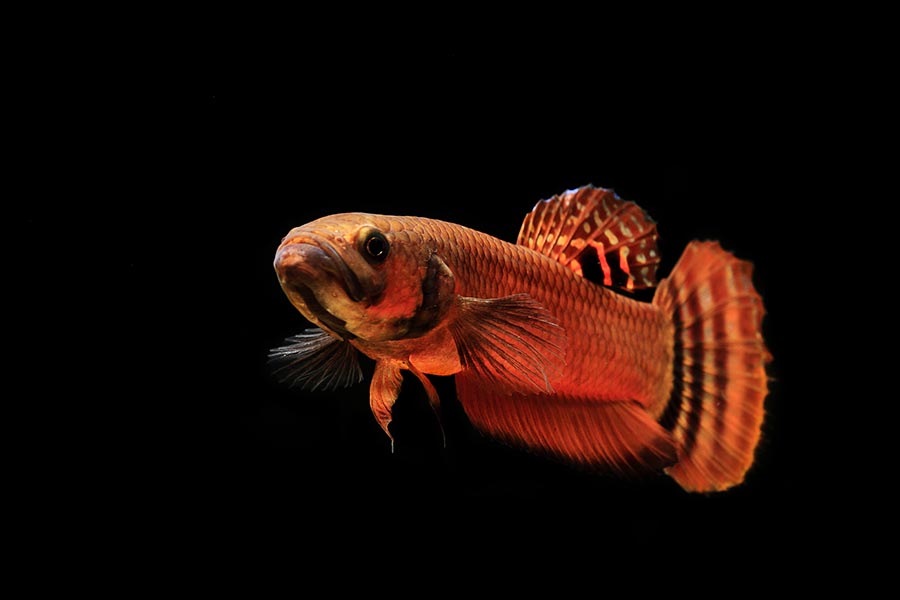
Betta macrostoma is one of the most prized mouthbrooding betta species. Its care, perhaps best described as “demanding” and “advanced”, presents a challenge for fish breeders to overcome. Image credit: Sumer Tiwari
Many fishes in the aquarium hobby have unique and beautiful ways of reproducing. Species under suborder Anabantoidei, especially, have a strange way of reproducing. Whereas many species in this suborder are bubble-nesters, some Betta species like the ones under the Unimaculata complex are known to be paternal mouthbrooders, meaning the males orally incubate the eggs until the fry are free-swimming.
Betta macrostoma is an iconic species from the Unimaculata complex. I have recently started working with this species again (I last kept them in 2014) and have been completely astonished while learning the details of their breeding process. Luckily, my pairs (I have three pairs) have spawned a few times during weekends when I happened to be at home and was able to watch the whole process.
Their breeding process consists of 6 main steps:
- Male’s courtship display
- Female’s courtship display
- Spawning Embraces
- Egg Transfer
- Oral incubation of eggs
- Release of fry
Male’s courtship display
Male Betta macrostoma can be seen performing courtship displays as young as just 6 months of age. Males have a peculiar way of doing this; they erect their fins and bend the body halfway at almost a 90-degree angle. They also move one or both of their ventral fins in a fashion similar to the behavior of courting Betta smaragdina ‘guitar’ males. Betta smargdina ‘guitar’ males move one of their ventral fins as if they were strumming a guitar. As male B. macrostoma attain their adult size, their courtship display skills get better. They start to look much bigger while they perform the display, which ultimately is what impresses the female.
I presume that the courtship display plays an integral part in the breeding process when these fish are in the wild. This is how the female would select which male would make the best partner to mate. In the aquaria, hobbyists like me usually only have one male available in the tank. This is done so that multiple males don’t end up fighting with each other over the female.
The male’s courtship display also helps the female get in the spawning mood. I have noticed that within a couple of days of a male performing an intense courtship display, the female goes in the corner of the tank and behaves very lethargic. She doesn’t move much and also doesn’t show any interest in food. It remains unclear why she feels vulnerable during this period. Is it when her body is producing eggs? The answer remains unclear. The male continues to go near the female to show off even when she is almost hidden in a corner of the tank.
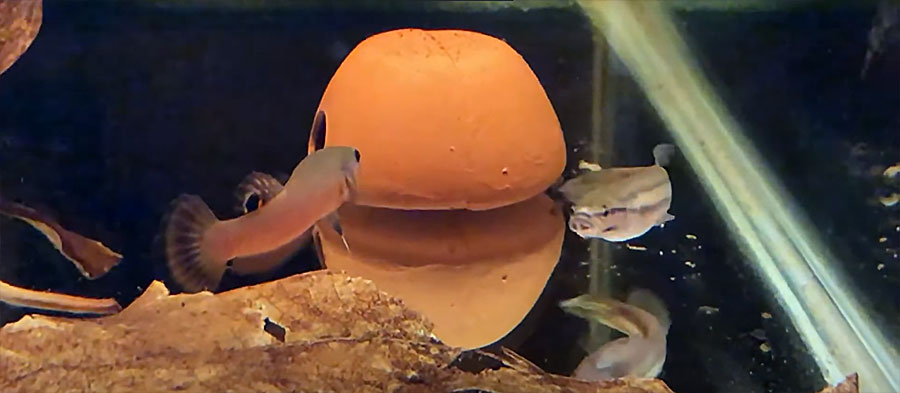
Step 2: The female Betta macrostoma changes coloration as spawning comes near, and performs a serpentine waggle dance for the male, signally her intent to mate.
Female’s Courtship Display
After staying almost dormant for a day or two, the female’s behavior changes dramatically. She loses all of her reddish-pink color. She develops two horizontal black lines across her body and the rest of her body becomes white. This is a great indication for the hobbyist to stop disturbing the pair and the tank they are kept in. This is the female’s indication that she is full of eggs and is ready for spawning.
She approaches the male and performs her courtship display which, to the human eye, looks more like a dance. She moves her tail and her head in a very peculiar way. The speed of this movement varies. At times she performs this dance at a very slow pace but at times, especially after a few embraces have taken place, she performs this dance at a relatively faster pace.
The male usually doesn’t perform his courtship display when the female is performing hers. If the female gets distracted, the male performs his courtship display to get the female’s attention back to the issue at hand.
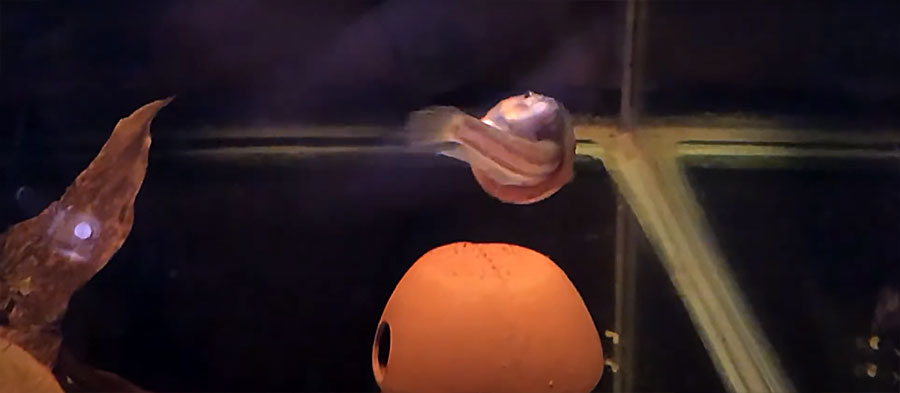
Step 3: Spawning embraces include both practice runs and the actual release of eggs and sperm, after which the female gathers the eggs.
Spawning Embraces
I have been breeding Betta splendens for the last 15 years. In my experience, the success rate of their embraces is more than 90%. That isn’t the case with Betta macrostoma. The success rate for B. macrostoma’s embraces is less than 20%. Based on my experience, 1 of 10 embraces results in females releasing the eggs and males fertilizing them. Most of the embraces don’t get completed because the male and female don’t attain the perfect posture required for the embrace.
I’d also like to point out that there is a possibility that this high failure rate may only exist in young pairs. As the pair matures, they might get better at embracing and they might not need as many practice runs to get to the successful one.
When the spawning embrace takes place, the female releases the eggs. Male anatomy places a huge role in getting all the eggs fertilized properly. The male’s big anal fin is positioned in such a way during the embrace that it acts as a platform for the released eggs to accumulate. When the eggs are released and the male releases milt to fertilize the eggs, by having the eggs stationary in male’s anal fin, it allows for a better chance for all the eggs to fertilize.
During the embrace, the male and female, are both stunned for a few seconds. It is the female who comes out of this mating stupor first and starts picking up the eggs that are resting on the male’s anal fin. If the male comes back to his senses before the female has completed picking eggs, eggs start to fall to the bottom of the tank. In that case, the male also tries to help by picking up the eggs. But if a few embraces have taken place already and the male already has eggs in his mouth, he will not risk opening his mouth to pick the eggs off the bottom. He understands the concept of gravity and knows that if he opens his mouth while looking down, eggs that are in his mouth will fall out.
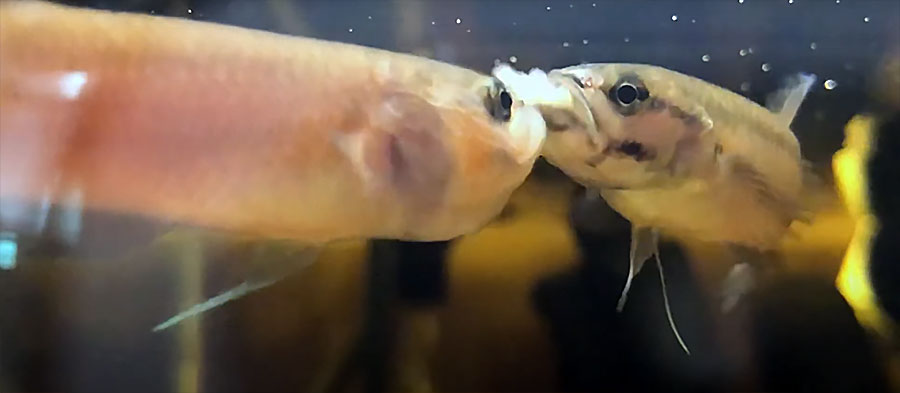
During the course of mating, successful spawning embraces are followed by the female transferring the eggs to the male, who will ultimately be responsible for their incubation.
Egg Transfer
Once the female has picked the eggs in her buccal cavity, she goes face-to-face to the male. The male knows what’s coming and pays undivided attention to the female. The female slowly spits out the eggs and the male catches them in his mouth. Trust me, the first time I witnessed it, I couldn’t believe my eyes. It seemed like something that you see on Discovery or National Geographic TV channels.
It might take her one or multiple attempts to transfer all the eggs from her buccal cavity to the male’s. Even when there are no eggs left, she continues to perform the action. This suggests that she doesn’t always know if her buccal cavity has eggs left or not. On the contrary, it might also mean that she wants to be extra certain that she doesn’t have any eggs left to be transferred.
This process of spawning embraces and egg releases continues until the female is exhausted of eggs. At that point, the male distances himself away from the female and usually likes to hide under a leaf or in a dark place.
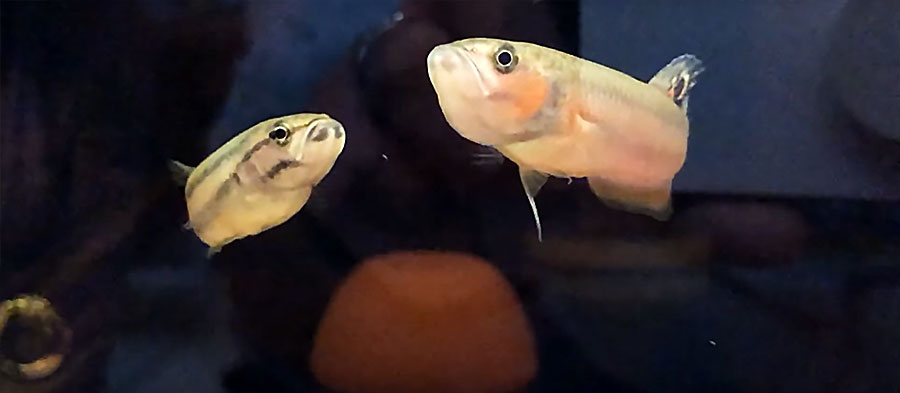
With mating complete, the male settles in for an incubation period that, if successful, can easily last 15-30 days without eating. Per the author, 21 days seems routine for his fish.
Oral Incubation
All the steps prior to this one were easy. This is the real test. Most Betta macrostoma males fail at this step.
By the time the pair has completed all the breeding activities, the female is very hungry. She hasn’t eaten in the last day or two. A good protein-rich meal satiates her hunger.
To take the female out or to leave her with the male is a question almost every Betta macrostoma keeper debates. The answer to this question is not so simple. It totally depends on the personality of the female. Some females are very docile. Once the male is holding, some females become calm and stay relatively quiet in the tank. Other females are not so accommodating. Right after spawning, they start to swim in circles close to the front glass begging for food. I have also noticed that when a male has a mouthful of eggs and cannot fit any more eggs, he loses interest in the spawning. But the female might still want to continue. In that case, the female tries to bully the male into swallowing the eggs so that they can continue to spawn. If any of these anti-social behaviors are noticed, the female should be taken out immediately. If the female is not bothering the male, she can be left in the tank for a few days.
If it is the first or second time for the male going through this process, chances are very high that he will not hold the eggs to term. In this case, taking the female out is pointless. Only when you know that the male has been holding the eggs for longer than 3-4 days should you bother removing the female. Once the male has proven himself and you already know the female’s expected behavior, you can act on it accordingly.
For example: For one of my pairs. I know the signs very well.
- Once the female hasn’t eaten for the last 24 hours and still has her belly full, I know she is getting ready to spawn.
- When the lights come on in the morning and the male is busy performing courtship display rather than begging for food, I know they will spawn in the next 3-4 hours.
- I also know that after the spawn, the male likes to be left alone and the female can be pushy. So as soon as I get back home from work in the evening, I take the female out and keep her in a separate tank.
- I cover my tanks with a towel. More details on this later in the article. This keeps light reflections/sudden movements etc. from spooking the male.
If the male is not going to hold to term, he is very likely to abort within the first 7 days of spawning. If 7 days have gone by and you can still see the male’s protruded buccal cavity, chances are that he will hold to term. However, this is not a guarantee that something won’t go wrong.
If the male gets spooked by any reason (i.e. a loud bang near the tank or high-intensity light flash etc), he might swallow the future generation, leaving you with nothing but sorrow. So please be very careful around this tank for the next three weeks.
Another important thing to remember is that the eggs will hatch within the first two to three days in the male’s buccal cavity. Fry have a large yolk sac at this point. As the fry continue to consume the yolk sac, the total volume that’s required to hold all the fry reduces. At this point (mostly 6-7 days into the incubation period) it might seem like the male’s buccal protrusion has reduced in size. To an untrained eye, it might seem like the male is not holding the fry anymore. In this case, be patient. Watch the male for at least 10-15 minutes continuously. If he is still holding fry, he will move them in his buccal cavity, giving you a visual indication that he is still holding. If you feel that you are 75% certain he has aborted holding the fry but want to be 100% certain, try to feed him. If he eats, that means he has aborted the holding term. If he shows any hesitation or comes to the food but has difficulty opening his mouth, know that you have made a mistake. You can either try to take the food out which might spook him or let the food be in the tank which might make the male abort and eat the food.
As he continues to hold, you will notice that he loses a considerable amount of body mass. Males that tend to hold for 20 days or more appear skinny after releasing the fry. While the male is holding, be patient and careful. Allow nature to work its magic.
Release of Fry
I don’t think we know what triggers the male to release the fry. Some males release the fry in 17 days and some do in 24 days. It can also be difficult to tell when the male has released the fry. Based on my experience, the male starts to yawn quite frequently after releasing the fry. It might be because the muscles in his buccal cavity have been caring for the fry for over 15 days at this point and he is simply trying to stretch them. That’s when I suggest looking carefully in the tank with a flashlight. You should see the fry in the tank.
When the fry are released, they are fully formed, free swimming and bigger in size than most betta fry from other species complexes. At this point, you can collect them using a turkey baster and place them in a container of your choice. Raising these fry is no different than raising any other species’ fry. I like to place them in a small Tupperware container which I simply float in the tank with the male. Many people chose to leave the fry with their father; the choice is yours.
Note that at this point, the tank hasn’t had a water change in the last 20 or so days. If you were lucky and had done a water change right before the pair spawned, you might be okay. But if a water change was already due when the pair spawned, by the time fry are released, your water might be in bad shape. I usually do a nice thorough cleaning and water change on the tank after the fry have been released.
When it comes to feeding the male after he has completed the incubation period, it is easy to get carried away and feed him in large quantities knowing that he hasn’t eaten anything in the last 20 days. Please tame your motherly instincts and start slow. The male has very low energy at this point. Feed him a diet rich in carbohydrates. I personally use the larvae of peanut beetles for this occasion. Around 25% of their body mass is carbohydrates and around 50% is protein. White worms or Repashy gel food are also good substitutes.
After going several weeks without feeding, sometimes the male will try to strike at or bite into the food, but amazingly fail in his attempts. This is not unusual. Give him a day or so to get his strength back and he will be hungrier than ever before.
I wait for about a week before introducing the female back in the tank with the male. During this bachelor week, I perform several water changes on the tank and feed the male twice a day with good quality foods. The best thing about Betta macrostoma is that they are not picky eaters. They will literally eat anything you throw in the tank. Things that I have tried to feed them with success include:
- Pinhead crickets
- Wingless fruit flies
- Daphnia
- While worms
- Grindal worms
- Peanut beetles
- Frozen bloodworms
- Frozen Mysis shrimps
- Frozen Artemia
- Frozen glassworms
- A homemade mixed fish recipe
- A homemade beef heart mix recipe
- Fluval Bug Bites
- Hikari Vibra Bites
- Repashy Gel foods, including Spawn & Grow, Grub Pie, and Igapó Explorer
- Sera Breeder Food
- Several flake foods
Watch the Video Footage Now!
Miscellaneous Tips:
- When the male is going through the incubation period, having caves or hiding areas in the tank is very important. I have used “Cichlid caves” or “Apistogramma caves” with success.
- I personally prefer not to keep any live plants or moss with Betta macrostoma. This is because my Betta macrostoma tanks hardly get any light. Why, you ask? Read the next point.
- Once bitten, twice shy; After losing this species to velvet back in 2014, this time I decided to put UV sterilizers in their tanks. Each tank has a 9W UV sterilizer in it. While some aquarists doubt the efficacy of UV sterilizeres, there have been a number of research studies demonstrating that UV sterilizers can successfully destroy the DNA of single-cell organisms and thus, kill them. Velvet is caused by a parasitic organism from the genus Oodinium. They are essentially a type of single-celled organism that is parasitic but can also photosynthesize to sustain themselves. Many of the experienced Betta macrostoma breeders claim that keeping their Betta macrostoma pairs in darkness helps to avoid contracting this disease. I decided to take a two-pronged approach. I have covered my aquariums with brown craft paper and towel to stop Oodonium from photosynthesizing and at the same time I have added UV filtration in the tank to destroy the remaining live single-celled organisms.
- Some master breeders believe in feeding their bettas once every two days. There are times when I feed them twice a day but I also skip on a meal every now and then.
- When my first male held eggs to term for the first time, the fry he released were damaged. Some had swim bladder issues and some didn’t have an eye. Only one of the fry was undamaged. A dear friend of mine, who is also a master breeder, told me that this can occur because, during the incubation period, the male may have bitten down too hard on the fry. According to him, the subsequent batches will yield better quality fry. As the male gains more experience, he will learn to take better care of the fry while holding.
- I have learned from master breeders to keep the water level not higher than 10-12 inches. I use 20 highs that are usually half-filled. This size aquarium has a large enough footprint for a pair.
- Please do not skip including biological filtration. Some hobbyists have a misconception that since bettas don’t utilize dissolved oxygen in the water to breathe, it’s okay to not have a sponge filter in the tank. The biggest role of the sponge filter is to provide biological filtration which breaks down fish waste.
- Pristine water quality is the key when keeping Betta macrostoma. Don’t let uneaten food stay in the tank. Large turkey basters that are usually used to spot feed corals and are very handy for removing uneaten food or large pieces of feces (yes, Betta macrostoma poop can be pretty big in size).
- When it comes to pH, I usually don’t worry much. The best pH is the one that you can maintain long term. Some master breeders go to great lengths to lower the pH by using Indian Almond leaves or peat. I personally pay more attention to the conductivity of the water. I keep Betta macrostoma in the water with a TDS of less than 10 ppm. I do add some Indian Almond Leaf extract in the water to give it a tint. I do this mostly to reduce the visibility underwater.
- This fish is still being exported out of its natural habitat—Borneo. If this is being done legally or illegally is unknown. Hobbyist led captive breeding programs reduce the demand on the wild population. This is particularly important, especially for a fish whose wild collecting process remains unknown. We don’t know if the process is sustainable or not. It is better to be safe than sorry and just assume the latter. As a result, whenever possible, I encourage you to seek out captive-bred Betta macrostoma.
I know this article was very long. I have a feeling that people who are first-time Betta macrostoma keepers will benefit from this article the most. If you see anything that I have overlooked, or a question you’d like address, please be sure to comment!

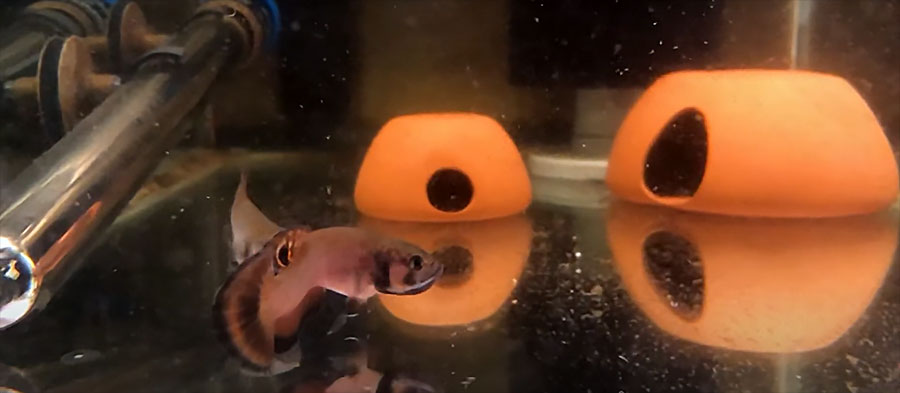
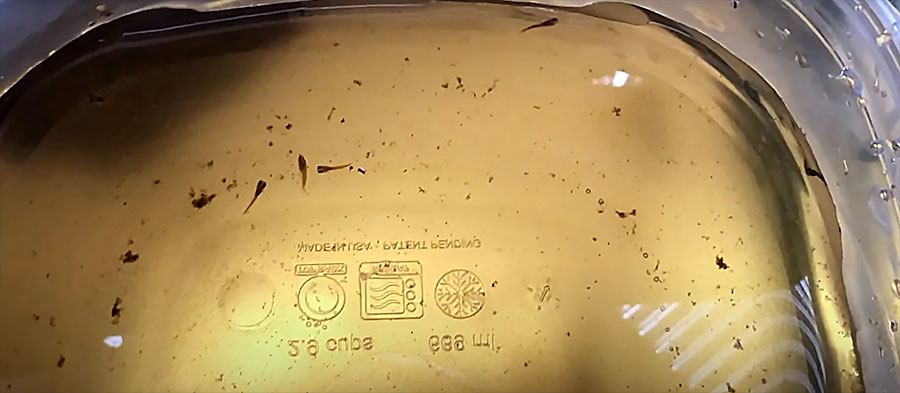





Comment on Breeding Betta macrostoma:
If the fry hatch in the males buccal cavity in 2-3 days did the author consider stripping the male of the eggs/fry the way mouth brooding African cichlids are done to hatch or rear the fry separately?
I have heard that can not be done but have not seen anything in writing for or against it.
Joseph, I too have heard that it can be done but have never done it myself or seen anyone else do it.
Since the males are known to eat the whole brood, I would suspect that it’d be very hard to strip the male of the fry.The male might just swallow the whole brood when the keeper would approach to catch the male.
Do you keep Betta macrostoma? Have you heard or seen someone practice “stripping” with Betta macrostoma male?
Sumer,
Thank you for your well written and comprehensive article. I enjoyed it very much and it is not too long at all.
I have kept bettas for about 60 years. My first pair spawned in a one gallon glass pickle jar, only one male survived to maturity.
You wrote that your water is less than 10 TDS. I assume you start with RO/DI water. What and how much do you add to get to 10 TDS?
In the egg exchange portion of the video, the male’s right operculum appears to be slightly malformed (too short). Is there a malformation or just a camera angle? I have seen 2 males with a malformed operculum. Too many inbred fish?
I’ve been giving the 2-3 day swallowing problem some thought. This 2-3 day or sometimes 5-7 day period from spawning to swallowing is consistently seen by many people trying to raise Macs. It can’t be that everyone startles their holding males on day 2 or day 5 and that makes them swallow the eggs. It seems to me that this behavior may be an instinctive response to non viable eggs. Somehow the male fish gets a signal (probably chemical) from the “rotting eggs” and that triggers the swallowing. The male swallows the eggs rather than spits them in order to conserve energy.
Fish sperm motility (swimming speed and duration) is strongly affected by the make up of the water, particularly the osmolarity. So TDS, or a very narrow range, may be THE factor that determines whether the sperm fertilizes the eggs and whether he swallows.
Currently, I have 16 adult Macs. I keep the pH at 5.5-5.8, the TDS less than 30 ppm.
In one 10 gallon tank there are 2 males and 1 female. The males chased each other at first. Now they watch each other, but there has been no damage to either. The female previously spawned with each of the 2 males in a 50+ gallon grow-out tank. I put them together hoping the female would spawn with each male in an alternating pattern. But today she spawned with both males, one after the other. it took about 7 hours. Both males are holding now. The female is resting.
What do you feed fry? I feed live BBS, and very finely ground Betta Bug Bites. Then switch to frozen Daphnia, fruit flies and white worms.
Marty
Marty,
Thanks for your comment.
It was just the video angle that made the male’s operculum look malformed.
I just published another blogpost where I discuss some more plausible reasons that might explain the swallowing of the eggs.
That being said, your comment about the osmolarity and its effect on the egg membrane does sound like a logical explanation. After reading your comment, I did do some more research on this topic and this seems to be a topic that was highly discussed and debated in mid 90’s among the discus breeders. Apparantly, breeding wild discus had similar challenges. Some scietists out of Germany then figured out a perfect combination of salts that they’d use in desalinated water to create the “perfect” water for breeding.
Since my second article came out, I have been experimenting with the recipe suggested by German discus breeders. If I see any proof that it supports and elevates fertilizing rates, I will definitely share with you and other AMAZONAS readers the recipe.
As far as feeding the fry is concerened, I kept them on BBS for the first 45-60 days and then switched them to white worms, SERA Grower Food, Adult Brine Shrimp and chopped krill. They seem to be growing very fast. I wish I could grow Daphnia. That’s one thing I have treid and failed many many times. Maybe someone can teach me how to grow daphnia indoors.
I breed the splendins just as a hobby. I have been doing research and want to breed the macrostoma. I am wondering if there is any chance of polluting the genetics? Will they x breed I suppose I am asking here?